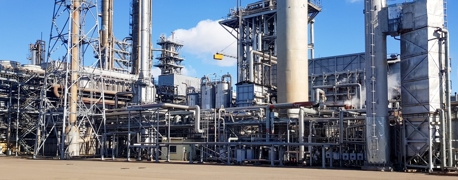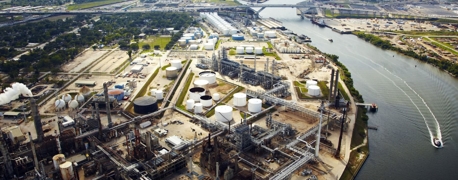The Effects of Cold Weather on Natural Gas Power Plants

What happens when power plants designed to withstand extreme heat are hit with freezing temperatures instead? One of the most recent examples of this (and the consequences of being unprepared for cold weather) occurred when Winter Storm Uri hit Texas.
Referred to as the "Winter Outbreak" by the National Weather Service, a strong Arctic cold front passed through southeast Texas in February of 2021. Snow and sleet fell across the state. Temperatures dropped down to a mere 5° Fahrenheit in College Station, 13° in Houston, and 20° in Galveston. Widespread power outages lasted for days, leaving millions of Texans freezing and in the dark. The Department of State Health attributed 246 deaths across 77 counties to what was one of the worst natural disasters in Texas history.
Of the facilities that power Texas (and that lost power in the outbreak), about half are natural gas power plants. With natural gas power plants in Texas, critical parts of the structure, like pipes and tanks, are intentionally exposed to the elements to avoid overheating. In other parts of the world, everything that’s used to move air, water, and gas around the plant would be enclosed to protect it from inclement weather.
To prepare for the cold temperatures of winter and everything that comes with it, natural gas power plants must winterize and be prepared for extreme heat, transitioning equipment and procedures to keep things running—no matter the season.
Winterization Works—If You Act in Time
Tragically, there had been warnings and time to prepare before the February 2021 Arctic front moved in.
10 years prior, Texas was hit by a storm that caused rolling blackouts across more than three-quarters of the state. The Groundhog Day blizzard struck from February 1 through 5, 2011, causing equipment failures at 241 plants and affecting approximately 4.4 million customers.
Many of the same power plants that had failed during the extreme cold of February 2011 froze and failed again in 2021. A full decade later, no substantial improvements had been made to winterize these plants effectively. Part of this is because, after 2011, recommendations were issued, but they didn’t have the same authority of mandated regulations. Since they were really just suggestions, too many natural gas plant operators failed to prevent pipes and water lines from freezing, causing critical equipment to malfunction. Sure, it would have been costly after 2011 to shore up reserves and winterize all the equipment, but it could have prevented the even costlier devastation and loss of life in 2021.
While Texas power plants were caught flat-footed, Oklahoma and New Mexico faced similar inclement weather but had much fewer outages, showing that preparedness works.
Winterization Is Critical Industrywide
Even if a natural gas power plant takes effective steps to be protected from freezing temperatures, this may not be enough on its own—not if the rest of the grid is compromised. That’s what happened to the Vistra Corp. power plant in Midlothian, Texas in February 2021. Winterization helped protect the Midlothian natural gas plant, but due to gas shortages and failures across the region, it was only able to operate at 30% capacity for much of the time. It couldn’t shore itself up, much less uphold the power grid, on its own.
Of course, other power plants in the state fared even worse because they hadn’t winterized at all, even with all the time to prepare after the 2011 Groundhog Day blizzard. The blame for these outages was placed on a failure to insulate pipes and to provide other protection on equipment ahead of freezing temperatures. More power plants must winterize in order to keep the power grid operational.
What Is Winterization for Power Plants?
Winterization is an important part of preparing a plant, refinery, or other facility for cold weather. This transition helps power plants continue operating safely and at the capacity required, despite inclement weather.
The main goal of winterization is to keep the necessary air, water, gas, and oil moving no matter how cold the temperature gets. Each of these elements is critical for operating the plant. For example, clean, dry air is needed for gas plants to run power-generating turbines. When running water, natural gas flows, or any other elements stop moving, operating the plant not only becomes less effective, but increasingly more dangerous. For instance, frozen water in piping can cause these pipes to crack, creating leaks, fire hazards, and other serious safety risks.
Winterization includes training workers and implementing procedures and upgrades such as:
- Insulation
- Temperature monitors
- Heat tracing (heated cables that run along piping)
- Adding pipe jackets
- Windbreaks
- Air dryers
For these efforts to be complete, winterization methods have to be carefully monitored and inspected to ensure that everything is functioning well and ready for adverse weather. When the cold weather has passed, procedures should be in place to return the facility back to normal operation.
While this is standard procedure for power plants in areas prone to cold weather, retroactively equipping power plants to withstand the cold is a newer consideration. It is also costly and takes time. For these reasons, warmer places like Texas didn’t start adopting winterization protocols until recently.
Protecting Workers with Winterization
It’s not just pipes and tanks that need to be winterized. The workers themselves must be protected from the cold, so personnel areas such as warehouse spaces, equipment rooms, and production floors need to be temperature-controlled. This can even be done temporarily with area heaters that are powered by either electricity or steam. Employers may also need to provide PPE such as warm-weather gloves that protect workers from the cold and the hazards of their work. Slippery surfaces must also be addressed, especially when the weather brings in snow or ice.
Companies can address slippery surfaces throughout the plant by prioritizing these steps:
- Spreading salt on sidewalks, in parking lots, and other essential outdoor areas
- Mopping up water that has accumulated on floors
- Placing caution signs near slippery areas and attending to them as soon as possible
Workplaces with 10 or more employees are required by OSHA to have a written emergency plan. Companies must prepare their workers for the possibility of emergency situations, especially before high-risk periods such as bitter winters. Explaining the impact on operations and the plan for emergency communications can help improve safety during these dangerous times. Simulating emergency drills and performing job hazard analyses can provide important data regarding hazards, allowing the company time to make changes and set standards to help prevent disasters.
Are Power Plants Required to Winterize?
As of December 2021, as a direct result of the catastrophic storm and blackout in February 2021, all Texas power plants are required to winterize each year. These energy reform laws called for the submission of winter weather preparedness reports to the Electric Reliability Council of Texas (ERCOT).
The laws did not, however, address the winterization of critical natural gas facilities, which means that power plants like the one in Midlothian could still be unregulated, even after new rules that were announced in March 2023.
Furthermore, even the plants that were addressed under newly announced rules are woefully inadequate. The Federal Energy Regulatory Commission set out new rules that mandate that Texas power plants need effective cold weather preparedness and winterization plans, something that even the FERC acknowledges is only a small step in the right direction
According to FERC Commissioner Allison Clements, these rules amount to requiring that “existing generators be able to perform for one hour at extreme cold temperatures beginning in April 2027. Yeah, one hour. Needless to say, that doesn’t bring us total comfort that we’ll be sure to get through the next multiday event like Winter Storm Uri.”
Also, the stated goal year is 2027. The rules in question aren’t specific or comprehensive enough either, as they’re just a start for setting up guidelines and monitoring compliance.
A July 2023 report found that these new implementations resulted in nothing more than write-ups for plants that weren’t ready to comply with winterization regulations. As of now, there is no real enforcement at play, not even fines, and only a small percentage of plants were flagged for winterization violations to begin with. Even though failure was widespread during Winter Storm Uri, only a fraction of the failing plants received citations from regulators over the lack of winterization and resulting power outages. In fact, most of the citations that were issued were just for missed paperwork, and there was no mention of the critical deficiencies involved, such as a lack of pipe insulation, old valve upgrades, and the like.
The missed paperwork in question? Failing to turn in a self-report that essentially says, “Yes, we have winterized and are prepared.” No inspection from an outside party was required to verify or monitor whether these plants had prepared for winter. While the new rules for winterization provided some specific measures to follow for safety, they are not yet required for compliance. Carrying out these safety measures is basically on an honor system right now.
Southern U.S. Natural Gas Power Plans Are Trying to Catch Up
Unlike their counterparts in New England and similar regions that are familiar with freezing temperatures, natural gas power plants in southern states tend to be built outdoors with extreme heat waves in mind. Northern states also have air dryers for their compressed air systems, which helps to keep lines from freezing. Southern states, however, often don’t have adequate moisture control, meaning that their compressed air systems can be greatly affected by freezing temperatures.
Winterization for summer-minded plants requires more than simple piping upgrades or installing heat tracing cables (though those would help). These power plants also don’t have the storage facilities and reserves on hand that have helped northern facilities last through weather emergencies. At nearly every level, southern power plants lack essential infrastructure to operate safely in extreme cold.
The greater frequency of extreme cold has not replaced extreme heat. Natural gas power plants now have to be prepared for hostile weather conditions at both extremes, which can spread budgets and project timetables thin. However, simply hoping for the best and failing to install, monitor, and maintain winterization equipment and processes means leaving workers as well as the surrounding communities with lingering, growing risks of leaks, toxic vapors, explosions, and more.
The need to take winterization seriously has grown even more urgent, as northern states also have been experiencing harsher winters. What’s worked for winter prep before won’t always be adequate. Whereas heater strips could have been enough protection for piping in the past, extreme cold can now break such equipment down, requiring plants to double up on winterization efforts, such as by combining both heater strips with insulation, and so forth.
What Happens If a Natural Gas Power Plant Doesn’t Winterize?
As we saw in 2011 and again in 2021, winterization is a critical step to protect not only the power grid but also natural gas power plants and their workers. The damage caused by cold weather can limit the output of the power plant, or worse, cause dangerous equipment failure that puts workers’ lives at risk.
Cold temperatures can cause catastrophic freeze damage to facilities such as:
- Frozen pipes, which may lead to leaks once they thaw
- Frozen compressed air systems, caused by high moisture levels in the air
- Broken power lines, snapped by the weight of accumulated ice
The need to winterize is now more urgent as storms that used to be a “once in a lifetime” or at least “once every 10 years” have started rolling in at an alarmingly higher frequency. Winterization is a crucial step in keeping the lights on throughout the winter, but it’s the workers who are put most at risk when these measures are not followed.
When air lines are compressed, piping freezes, or other damage occurs because a natural gas facility was unprepared for extreme cold, the blame often lies with plant owners and operators. These companies have a responsibility to their employees to put safety over profits. When they fail in this duty, and instead place their workers and the surrounding communities at risk from leaks, fires, and more because of cold-damaged equipment, they need to be held accountable.


